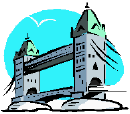- What am
I doing here?
At the end of this course, you will be able to: analyze
structural engineering problems (beams, cables, and trusses) in a simple
and logical manner; use the concepts of stress and strain in structural
members experiencing tension, compression, shear, bending, and twisting
to evaluate the possibility of their failure; and use Mohr's circle and
the Von Mises stress to ensure that your analysis is performed from the
appropriate perspective. The first part of the course focuses on the
analysis of “rigid bodies” in equilibrium. The second part of the course
focuses on structures made of “real” materials having elasticity and
finite strength.
|
-

|
- There are two textbooks
for this class: Vector Mechanics for Engineers – Statics, by
Beer, Johnston & Mazurek (McGraw Hill, any edition), and
Mechanics of Materials, by Beer, Johnston et al. (McGraw Hill, any
edition). These books will be used in the first and second
parts of the course, respectively.
-
- Hey!
Why are there two books?
This material is typically presented in two different courses at
engineering schools, and these are the texts for those courses. We will
cover chapters 1 through 7 of Statics, and 1 through 9 of
Materials. Both books have great example problems and illuminating
text. If you are planning on a career in mechanical, civil, or
environmental engineering, I strongly recommend that you purchase and
keep both books, even after the semester ends.
|
 |
- How will I be graded?
Your grade will be determined by:
| |
Assignments: |
30% |
|
| |
Bridge Competition |
10% |
|
| |
Exams (4 exams): |
60% |
|
| |
|
100% |
|
Each of
the four exams (including the “final”) will cover the specific material
from the weeks preceding it. However, all of the exams are effectively
cumulative for the course, since you cannot master the material for the
second exam unless you understand the material from the first (and so
on). Really.
For this
course, using online homework solutions is considered academic
dishonesty. Students must not turn in homework problems that someone
else has solved or solutions they find online. At best you will not
receive credit for the homework; at worst you will be charged with
academic dishonesty.
The bridge
competition will be held in Newton 204 beginning at 3:45 pm on Thursday,
December 4, 2025.
Can I do
written homework on Post-it notes?
Are you kidding? In the real world, neatness counts, and it
counts in this class, too. The main purpose of the (rare) written
assignments is professionalism. More information concerning
written homework can be found on the reverse side of this syllabus. Take
it seriously!
|
 |
|
|
|
When are the
tests?
Here is a tentative schedule of exams. Exams #1 through #3 are
currently scheduled as 50 minute “in class” exams. If the entire class
(including Dr. Pogo) agrees, then any exam time, date, or length can be
changed (to a two hour evening exam, for example). Such changes will not
affect the exam questions itself. In any case, the time limit for exams
#1 through #3 will not exceed two hours.
-
Exam #1: Friday, September 19, 2025 (chapters 1 through 5 of
Statics)
-
Exam #2: Friday, October 17, 2025 (chapters
6
through 7 of Statics)
-
Exam #3: Wednesday,
November 12, 2025 (chapters 1
through 3 of Materials)
-
Exam #4: Friday, December 12, 2025
(noon - 2:30 pm. Covers chapters 4 through 9 of Materials)
Schedule
of Assignments
|
CAPA |
Topic |
Due Date |
Which Exam? |
|
1 |
FBDs,
equivalent systems |
Wed, Sep 3,
2025 |
1 |
|
2 |
Reactions |
Wed, Sep
10, 2025 |
1 |
|
3 |
Centroids &
distributed forces |
Wed, Sep
17, 2025 |
1 |
|
4 |
Trusses |
Fri, Sep
26, 2025 |
2 |
|
5 |
Machines |
Wed, Oct 8,
2025 |
2 |
|
6 |
Internal
forces and moments |
Wed, Oct
15, 2025 |
2 |
|
7 |
Average
stress |
Fri, Oct
24, 2025 |
3 |
|
8 |
Elongations
& Hooke’s Law |
Fri, Oct
31, 2025 |
3 |
|
9 |
Torsion |
Fri, Nov 7,
2025 |
3 |
|
10 |
Bending &
deflections |
Mon, Nov
24, 2025 |
4 |
|
11 |
Shear |
Wed, Dec 3,
2025 |
4 |
|
12 |
Combined
Stress; von Mises |
Wed, Dec
10, 2025 |
4 |
|

|
-
- Written
Homework Rules
- The entire
point of having written assignments is to help you improve your
professionalism. Therefore, unlike the CAPA portion of each weekly
assignment, your grade will be primarily based on factors other than
whether you get the right answer.
- 1) Use exactly 8˝
´
11 inch paper. I will measure it with a ruler. Do not use spiral
ring paper.
- 2) Use only one side of
each sheet.
-
3)
Type your work. Use correct notation:
italics only and always when needed, subscripts as appropriate,
equations in standard textbook form (not in “Mathematica” code),
etc. The symbol “:=” is (now and for the rest of your professional
life), unacceptable for written work, along with other
“computational” notation (“^”, “E”, “*”, etc.).
-
4) Put your name on the top of
every sheet. Put the assignment number on the top of the first page
(e.g., “Applied, Assignment #3).
-
5) Staple all your
sheets together. Paper-clips and torn corners are not permitted.
-
6)
Clearly and systematically indicate
what is given, and what is sought.
-
7)
Work must progress linearly down the
page. If your solution initially meanders around the page, I expect
you to recopy your solutions.
-
8) Draw and use Free Body
diagrams as appropriate for all problems. Define and use coordinate
systems. Specify your choice of “free body”. Label your forces.
-
9) Define your symbols,
and use subscripts. Not all forces can be called “F”,
not all tensions can be called “T”, and not all normal forces
can be “N”. Every symbol must be unique and clearly defined.
Make a list or table of relevant symbols and their values when this
will help me to understand your solution.
-
10) Do not even bother to
submit nonsensical results (e.g., a negative tension in a chain or
rope).
-
11) Use words and/or
pictures to clarify your method of solution and your symbol
definitions.
-
12) Solutions should be
symbolic… don’t use your CAPA generated values until the very last
step (and often, not even then). Include the initial fundamental
formulas, but don’t show every step of intermediate algebra. If, for
some unusual reason, your solution uses actual numeric values, show
no more than 4 significant figures, and include units.
-
13) Box your answers.
-
14) Plots should be professional and no smaller than 3
´
4 inches. Do not use default font sizes, default trendline
formatting (where every variable is apparently
-
an x or a
y),default line widths, default colors, etc. No
decision should be made by Excel or Mathematica. Axis names should
include units.
-
- What if
I have trouble with the homework?
Come see
me during office hours on Discord, and I’ll try to point you in the
right direction. You must bring a paper copy of your homework assignment
(not just your “answers”). Also,
I know that most of you will
work in groups, and I won’t attempt to stop it. However, the learning is
in the doing. Nobody on this planet learns from copying somebody else’s
work, no matter how clear or correct it is. Every part of every problem
that you let somebody else do for you is something that you are deciding
that you just don’t want to learn. You will not have their help on
exams!
Learning Outcomes:
At the end of this course, students will:
-
· Be
able to analyze rigid structural engineering problems consisting of
beams, cables, and trusses in a simple and logical manner
-
· Be
able to evaluate the possibility of failure due to tension and
compression in structures made of elastic materials of finite
strength
-
· Be
able to evaluate the possibility of failure due to torsion in
structures made of elastic materials of finite strength
-
· Be
able to evaluate the possibility of failure due to bending in
structures made of elastic materials of finite strength
-
· Be
able to evaluate the possibility of failure due to shear in
structures made of elastic materials of finite strength
-
· Be
able to use Mohr’s circle and the “von Mises stress” to combine the
above effects in 2D and 3D, respectively, to ensure that your
failure analysis is performed in the correct coordinate system.
Also, the college
provides information at the following URL relating to a variety of
topics:
https://sunygeneseo.sharepoint.com/sites/provost/sitepages/syllabus%20resources%20related%20to%20student%20success/syllabus-resources-related-to-student-success.aspx?web=1
|
|
| |


